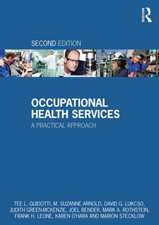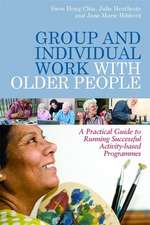Use of Mechanistic Information in Risk Assessment: Proceedings of the 1993 EUROTOX Congress Meeting Held in Uppsala, Sweden, June 30–July 3, 1993: Archives of Toxicology, cartea 16
Editat de Hermann M. Bolt, Björn Hellman, Lennart Denckeren Limba Engleză Paperback – 29 dec 2011
Din seria Archives of Toxicology
- 5%
 Preț: 725.07 lei
Preț: 725.07 lei - 5%
 Preț: 376.06 lei
Preț: 376.06 lei - 5%
 Preț: 729.42 lei
Preț: 729.42 lei - 5%
 Preț: 382.43 lei
Preț: 382.43 lei - 5%
 Preț: 720.47 lei
Preț: 720.47 lei - 5%
 Preț: 1096.98 lei
Preț: 1096.98 lei - 5%
 Preț: 731.43 lei
Preț: 731.43 lei - 5%
 Preț: 724.50 lei
Preț: 724.50 lei - 5%
 Preț: 723.21 lei
Preț: 723.21 lei - 5%
 Preț: 733.66 lei
Preț: 733.66 lei - 5%
 Preț: 1105.21 lei
Preț: 1105.21 lei - 5%
 Preț: 721.19 lei
Preț: 721.19 lei - 5%
 Preț: 732.36 lei
Preț: 732.36 lei - 5%
 Preț: 725.07 lei
Preț: 725.07 lei - 5%
 Preț: 725.79 lei
Preț: 725.79 lei - 5%
 Preț: 738.41 lei
Preț: 738.41 lei - 5%
 Preț: 732.92 lei
Preț: 732.92 lei - 5%
 Preț: 730.71 lei
Preț: 730.71 lei
Preț: 641.71 lei
Preț vechi: 754.95 lei
-15% Nou
Puncte Express: 963
Preț estimativ în valută:
122.79€ • 128.53$ • 102.20£
122.79€ • 128.53$ • 102.20£
Carte tipărită la comandă
Livrare economică 31 martie-14 aprilie
Preluare comenzi: 021 569.72.76
Specificații
ISBN-13: 9783642786426
ISBN-10: 3642786421
Pagini: 324
Ilustrații: VIII, 312 p.
Dimensiuni: 155 x 235 x 17 mm
Greutate: 0.45 kg
Ediția:Softcover reprint of the original 1st ed. 1994
Editura: Springer Berlin, Heidelberg
Colecția Springer
Seria Archives of Toxicology
Locul publicării:Berlin, Heidelberg, Germany
ISBN-10: 3642786421
Pagini: 324
Ilustrații: VIII, 312 p.
Dimensiuni: 155 x 235 x 17 mm
Greutate: 0.45 kg
Ediția:Softcover reprint of the original 1st ed. 1994
Editura: Springer Berlin, Heidelberg
Colecția Springer
Seria Archives of Toxicology
Locul publicării:Berlin, Heidelberg, Germany
Public țintă
ResearchCuprins
Baltic Sea Pollution.- Ecology of the Baltic — Introduction.- Presence and Sources of Pollutants in the Baltic Sea.- Interrelationship Between Eutrophication and Effects of Pollutants.- Effects of Toxic Metal Pollutants on the Ecology of the Baltic Sea.- Effects of Persistent Organic Pollutants on Biota in the Baltic Sea.- Human Health Risk Assessment and Risk Perception Related to the Baltic Sea.- Contact and Respiratory Sensitisation.- Immunoregulation of T Cell-Mediated Skin Hypersensitivity.- Test Methods for Contact Sensitisation.- Test Methods for Respiratory Sensitisation.- Newer Approaches to the Evaluation of Sensitisation Phenomena.- Risk Assessment of Sensitizing Agents.- Developmental Toxicity.- Nuclear Retinoic Acid Receptors and Regulation of Gene Expression.- The Role of Retinoids in Normal Development and Retinoid-Induced Malformations.- Retinoid Teratogenesis: Toxicokinetics and Structure-Specificity.- The Neurochemical Effects of PCB Exposure are Age-Dependent.- Risk Estimation and Primary Prevention of Birth Defects.- Role of Mechanistic Studies of Toxicity in Risk Assessment.- The Role of Mechanistic Studies in Understanding Target Organ Toxicity.- Rational Species Extrapolation of Toxic Effects.- Predicting the Toxic Dose or Concentration. Is there a Difference?.- The Role of Investigative Toxicology in Pharmaceutical Industry.- Mechanisms of Metal Toxicity.- Metal-Induced Autoimmunity.- Genotoxic Effects of Metal Compounds.- Toxicokinetics of Drugs.- The Importance of Exposure Measurements in Risk Assessment of Drugs.- The Impact of Genetic Polymorphisms in Risk Assessment of Drugs.- Kinetic Analysis Using Positron Emission Tomography.- The Application of Modelling in Toxicokinetics.- Alterations in Kinetic Parameters Resulting in Modification ofToxicity.- Mechanisms of Carcinogenicity and Risk Assessment.- Importance of Genetic Alterations in Tumour Development.- Transgenic Mouse Models in Chemical Carcinogenesis Studies.- Cell Proliferation and Cell Death in Rat Liver Carcinogenesis by Chemicals.- Use of Mechanistic and Other Data in Identifying Carcinogens: A Review Based on the IARC Monographs Programme.- Late Manuscripts.- Developmental Toxicity — Magnitude of the Problem.- Health Problems Related to Respiratory Sensitisation.- Young Scientists Poster Award.- Neonatal Exposure to the Organophosphate DFP Induces Changes in Behaviour and Muscarinic Receptor Density in the Adult Mous.






